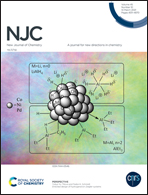Improving the electrocatalytic activity and stability of spinel sulfide counter electrodes by trimetallic synergy effects for quantum dot sensitized solar cells†
Abstract
Spinel trimetallic sulfide M0.5Ni0.5Co2S4 (M = Cu and Mn) nanostructures are designed and synthesized for the first time via a facile one-pot solvothermal strategy and used as efficient counter electrodes (CEs) for quantum dot sensitized solar cells (QDSSCs). Electrochemical tests show that the interface charge transfer resistance (Rct) of Cu0.5Ni0.5Co2S4 is only 0.79 Ω, which is less than half of the Rct of NiCo2S4 (2.04 Ω). The best power conversion efficiency of QDSSCs assembled with the TiO2/CdS/CdSe/ZnS photoanode and Ti-mesh substrate Cu0.5Ni0.5Co2S4 CE reaches 5.20%. The superior electrocatalytic activity toward Sn2− reduction is attributed to the synergy effects of multiple transition metal heteroatoms, and the outstanding stability may stem from the distorted structures of spinel trimetallic sulfides. This work exhibits the potential of spinel trimetallic sulfides to be competitive CE material candidates for efficient QDSSCs.



 Please wait while we load your content...
Please wait while we load your content...